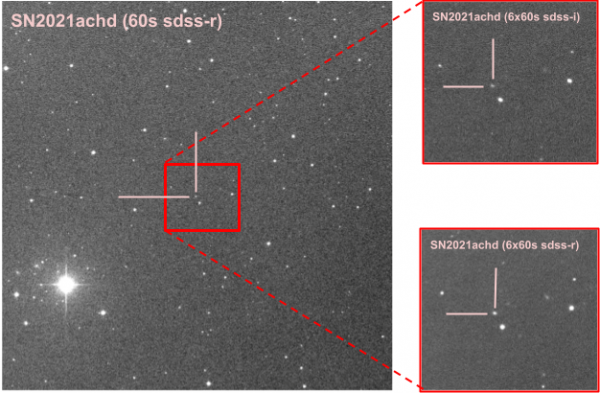On 9 November 2021, the French Science Center (FSC) of the SVOM mission generated and sent its first alert to a ground-based robotic telescope for automatic photometric monitoring. This first test was carried out with the 50 cm robotic telescope IRiS (Initiation à la Recherche en Astronomie pour les Scolaires) located at the Observatoire de Haute Provence during a SVOM scientific meeting held there. The objective of this test was multiple:
- test the FSC’s alert generation and delivery system;
- test the real-time communication between the FSC and observers from outside the SVOM collaboration;
- ensure the proper transmission of SVOM alert information and optical tracking by ground-based robotic telescopes;
- analysing images taken in order to identify the transient source at the origin of the SVOM alert.
For this test, the FSC teams used the coordinates of a still relatively bright Type Ia supernova, SN2021achd/ZTF21aciwkzc (detected by the US ZTF optical survey on 7 November 2021), to simulate the position of a gamma-ray burst that would have been detected by the ECLAIRs instrument on board the SVOM satellite. On 27 October 2021 at 21:15 (local time), the FSC transmitted the alert to the IRiS telescope via a dedicated communication channel. Between the generation of the SVOM alert and its transmission to the IRiS telescope, only 1 to 2 seconds elapsed. It took a few more tens of seconds for the IRiS observation scheduling system to schedule the observation and point the telescope at the target to acquire the first follow-up image. In total, about 1 minute will have elapsed between the reception of the alert and the start of IRiS acquisitions. In total, a sequence of 79 images was taken during the rest of the night (60x5sec exposure with an sdss-r filter, then 9x60s in sdss-r and 10x60s in sdss-i). Each image taken by IRiS was stored in real time in a shared directory with the FSC, which was then able to analyse the images.
The precise analysis of the images is still underway, but supernova 2021achd was clearly detected in both the individual and cumulative images (see Figure 1).

In the context of the monitoring of a SVOM gamma-ray burst, the photometric analysis will make it possible to study the temporal behaviour of the optical transient source. This analysis will make it possible to identify whether the flux evolution of the transient source is in agreement with the expected light curve for a gamma-ray burst. The automation of this type of analysis is underway in order to be as reactive as possible as soon as IRiS images are taken.
This test was therefore conclusive in every way. It demonstrated the ability of the SVOM alert system to quickly deliver crucial information to the ground-based telescope teams in order to characterise the transient sources of interest as quickly as possible.

Further tests will take place in the coming months to collect more statistics on the stability of the SVOM alert system and to fine-tune the observing strategies. In parallel, real-time observations of gamma-ray burst alerts detected by the US Swift mission and redistributed by the FSC will also be scheduled in the coming months with SVOM partner telescopes.

